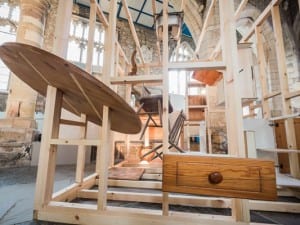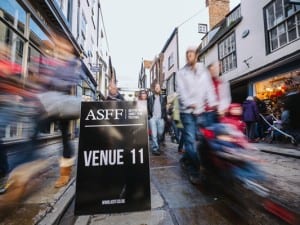Alfredo Jaar represents Chile at this year’s Venice Biennale. We speak with curator Madeleine Grynsztejn about Latin American art and Jaar’s installation Venezia, Venezia.
The history of the Venice Biennale is lengthy and involved. First established in 1895 (only a year before the first Summer Olympics of 1896), the Biennale was conceived of as a way for nations to compete on an artistic level. Like the world’s fairs of the earlier 19th century, the Biennale offered an opportunity for nations to exhibit their artistic and cultural strength and development. In a sense the Biennale still functions in the same way, with each exhibition changing and growing as more countries and artists participate in some shape or form. This year’s event includes 10 new countries (Angola, The Bahamas, the Kingdom of Bahrain, Ivory Coast, the Republic of Kosovo, Kuwait, the Maldives, Paraguay, Tuvalu and the Holy See). Curator Massimiliano Gioni has, quite suitably, selected as inspiration for this year’s edition the model of a utopian dream by Marino Auriti as articulated through his Il Palazzo Enciclopedico (The Encyclopedic Palace), which is “an imaginary museum that was meant to house all worldly knowledge.”
Discussions of intellectual, artistic and political legitimacy tied to the Biennale underscore its original intent, which was more commercially based. The event was originally founded in 1893 as a way to support and encourage the art market. In 1968, protests led to the abolition of the sales offices and the Grand Prize. Since then, the Biennale has evolved away from overt commercialisation but out of this has emerged the so-called “Venice effect.” In the June 2011 edition of The Art Newspaper, Olav Velthuis states that “showing in Venice is widely perceived as a signal of artistic quality, lending legitimacy to an artist’s oeuvre and therefore contributing to shaping collectors’ tastes (read: their willingness to pay for art).” The Biennale is not just a way of promoting artists and the art market, however; as an international exhibition, it has historically been used as a method or conduit of protest. This is evidenced by the dedication of the entire 1974 edition to Chile. Organised as a cultural protest by the then-president of the event, Carlo Ripa di Meana, in response to the recent military coup, it was one of the largest international remonstrations against Pinochet’s regime. Ripa Di Meana selected as that year’s theme “Freedom for Chile.” This overt challenge is just one side of the coin, with artists from Latin America struggling under various dictatorships to find a way to create art that would fall under the radar of political and cultural censorship.
Alfredo Jaar (b. 1956), who has been selected to represent Chile at this year’s Biennale, has chosen to focus on the event as it exists as an institution and cultural framework of support. His installation, Venezia, Venezia, is, in curator Madeleine Grynsztejn’s words: “A critique; a reminder of the historical origins of a nationalist programme and of the inherent blind spots in that programme (beginning in the 19th century) that pertain to today. What he points out vividly is how our cultural, historical and political blind spots continue to trip us up.”
Jaar, born in Santiago, left Chile in exile in 1981 under the Pinochet regime, and his work reflects the influence of his heritage and experiences, being, as it is, highly political and concerned with addressing social issues. The Biennale, as an international event, provides an opportune stage for Jaar to exhibit and display his criticisms. This is the second time he has participated, with his debut in the 1986 edition being as part of the Achille Bonito Oliva curated Aperto exhibition. Jaar trained as an architect and filmmaker, and this is reflected in his greater concerns with social and urban spaces, which were visually articulated through his contribution to Aperto of Gold in the Morning (1986). The work documents the miners and labourers at work in Serra Palada, a gold mine in north eastern Brazil, and was originally presented in New York City subway systems as posters (alongside text) indicating the fluctuating world gold prices. It stands as a subtle but scathing study of the working conditions, along with the social and economic framework, that breed such appalling conditions.
Even with the 1986 edition’s emphasis on marginal and/or struggling countries, the biennials and international art exhibitions of the 1970s and 1980s continued to be populist, focusing on Europe and North America. Bruce Altshuler states in his introduction to Biennials and Beyond: Exhibitions That Made Art History: “It was the first Havana Biennial in 1984 that prefigured the expansion of major exhibitions beyond Europe and North America … In its anti-imperialist rhetoric and attempt to bring together artists from Latin America, the Caribbean, Africa and Asia – an intention only realised in its second incarnation – the Havana Biennial became an ideological prototype, a model whose postcolonial politics would focus increasingly on the dislocations of globalisation.” Luis Camnitzer, in an article discussing the second Havana Biennial in Arte en Colombia (May 1987), argues that the lack of Latin American artists in supposedly “international” art exhibitions and biennials (for instance documenta VII had only one Latin American artist: Jaar) spurred the creation of smaller localised offshoots. The growth of biennials has been rapid since then, with over 40 established in the 1990s, but this is not to say that the intent and importance of these events has been diluted. Grynsztejn says: “They are important in providing an [alternative] avenue other than that of art fairs and auctions. This provides a salutary balance and reminder of why artists and their interpreters do what they do in the first place, which is to create art, ideas and conversations around the most important issues of our time.”
Historically, at the Venice Biennale, Latin America has been primarily represented through the Latin American pavilion organised by IILA (Italo-Latin American Institute). This has changed, particularly within the past 10 years, with countries (Brazil, Argentina and Chile) all exhibiting independently with their own specific pavilions. The emphasis on their own localised culture and heritage is particular to the exhibiting artists of these countries. This may come across as an all-encompassing, naïve statement, but on looking at the list of these artists it becomes glaringly obvious. Brazil’s pavilion, curated by Luis Pérez-Oramas, includes the work of Hélio Fervenza, Odires Mlászho, Lygia Clark, Max Bill and Bruno Munari. Each of these selected artists references the art historical past and pedagogy but presents them as uniquely their own. A focus on organic, fluid shapes and forms as related to design is evident in each of the aforementioned artists’ work.
Jaar’s “Public Interventions” – individual art projects concerned with specific social or political issues – have helped to raise the profile of pressing concerns throughout the world, whether homelessness in Montreal, Quebec (1999), or genocide in Rwanda (The Rwanda Project, 1994-2000). Grynsztejn says that his work has “become less dogmatic, more subtle, always powerful”, and arises out of the volume of information that he digests on a daily basis. Jaar describes his practice (in an interview with Art21, PBS) as: “A response to a real-life event; a real-life situation. That’s why I always describe myself as a project artist. I’m not a studio artist; I do not create works in my studio. I wouldn’t know what to do. I do not stare at the blank page of paper and start inventing a world from my imagination. My imagination starts working based on research, based on a real-life event – most of the time, a tragedy – that I’m just starting to accumulate information about, to analyse, to reflect on.” Venezia, Venezia arose out of his reflections on the actual infrastructure and history of the Biennale and its historical responses to the surrounding international political and social climate. In his installation for the Biennale, Jaar presents a 1946 photograph of Lucio Fontana, standing amongst the ruins of his studio in Milan, reflecting on the literal damage caused by World War II. This image serves to contextualise the relationship between art and the surrounding political, economic and social climate from which it is produced and that it exists within. Grynsztejn argues: “There is a parallel here that Jaar constructs about artists who move in and out of history and whose work and life are impacted upon very deeply by a larger context. This is a way of waking all of us up to how we ourselves are affected by and accountable to the past.”
He moves on from this starting point to a sculptural, kinetic architectural rendition of the Giardini. Jaar has recreated the 28 pavilions (on a 1:60 scale) and placed this sculpture within a 5 x 5m pool of water, from which it emerges approximately every six minutes, only to disappear, submerged beneath the surface once more. There is an element of rebirth every time the Giardini re-emerges, but also an allusion to the inadequacy of the traditional infrastructure of the biennial in the contemporary, evolving and increasingly global art world. As Grynsztejn elaborates, the Biennale has become paradoxically truly international and hyper-local, and Jaar’s work pinpoints this strange dichotomy through his inclusion of only the traditional Giardini. Geographically small, it is only capable of hosting 28 pavilions, and must necessarily exclude new additions. The Giardini becomes localised within a larger international context.
Photography is an important tool for Jaar in his work, allowing him to capture the reality of the situations and events he chooses as his subject, but he is cognisant of the fact that it is not an unmediated reality he depicts. As Susan Sontag argued in On Photography (1977): “To photograph is to appropriate the thing photographed.” It is impossible to depict a neutral view and, in many ways, this is why Jaar’s work is so successful: it is not neutral and it is in its very decisive, inherent criticisms via the selected view that the images become arguments in themselves. With Gold in the Morning, the documentary form of photography that Jaar employed allowed the Biennale’s audience a glimpse into the harsh reality of the industrial mining techniques of Brazil. This was 20 years before the populist 2006 film, Blood Diamond, which helped to bring to light the stark conditions and economic illegitimacy of various international mining techniques and dealings. Jaar thus assisted in bringing to the forefront, at a much earlier stage, issues regarding the exploitation of the local communities and labourers by large, international conglomerates.
His work often appears anthropological in its enquiry, documenting and following the lives and trajectories of various social groups and people, which is a difficult method of working, as it would be quite easy to exploit the subject. Grynsztejn says that he is incredibly aware of this easy pitfall and that his work, particularly in Rwanda, illustrates this anthropological quandary. Jaar took thousands of photographs in an attempt to record the effects of the genocide on the Rwandan people as well as on the landscape itself. The images are haunting and distressing, yet never reduce the subject to an object of pity or fascination. Rather, as an audience, we are shocked by the fact that the massacre happened so recently and to such a violent, deadly end without an immediate international intervention.
This harsh reality of his images is propounded by the knowledge that they may not produce in some viewers the outraged reaction that one would expect; as society has become increasingly inundated with images of war and social atrocities it has simultaneously become immune to the images’ effects. Jaar’s 2002 kinetic work Lament of the Images articulates this reality of the increasing insufficiency of the visual image to provoke audience response and protest. The work consists of two light tables – one suspended over the other – with the top one lowering to meet the other, serving to extinguish the bright light emitted, giving way to total darkness. The initial excessive white light, which momentarily blinds the viewer, alludes to the flood of images received on a daily basis and then, as it is cut off, censorship.
Jaar’s inclusion in this year’s edition of the Biennale comes at a seminal moment as the increasingly global art world is expanding faster than seems logical or manageable. This necessarily provokes the question “Can it continue?” Jaar’s response, Venezia, Venezia, does not provide an answer but calls for a reevaluation and reincarnation of the traditional structure of the foundation. Whether this will occur remains to be seen.
Alfredo Jaar represents Chile at the Venice Biennale with Venezia, Venezia from 1 June until 24 November. www.labiennale.org.
Niamh Coghlan





